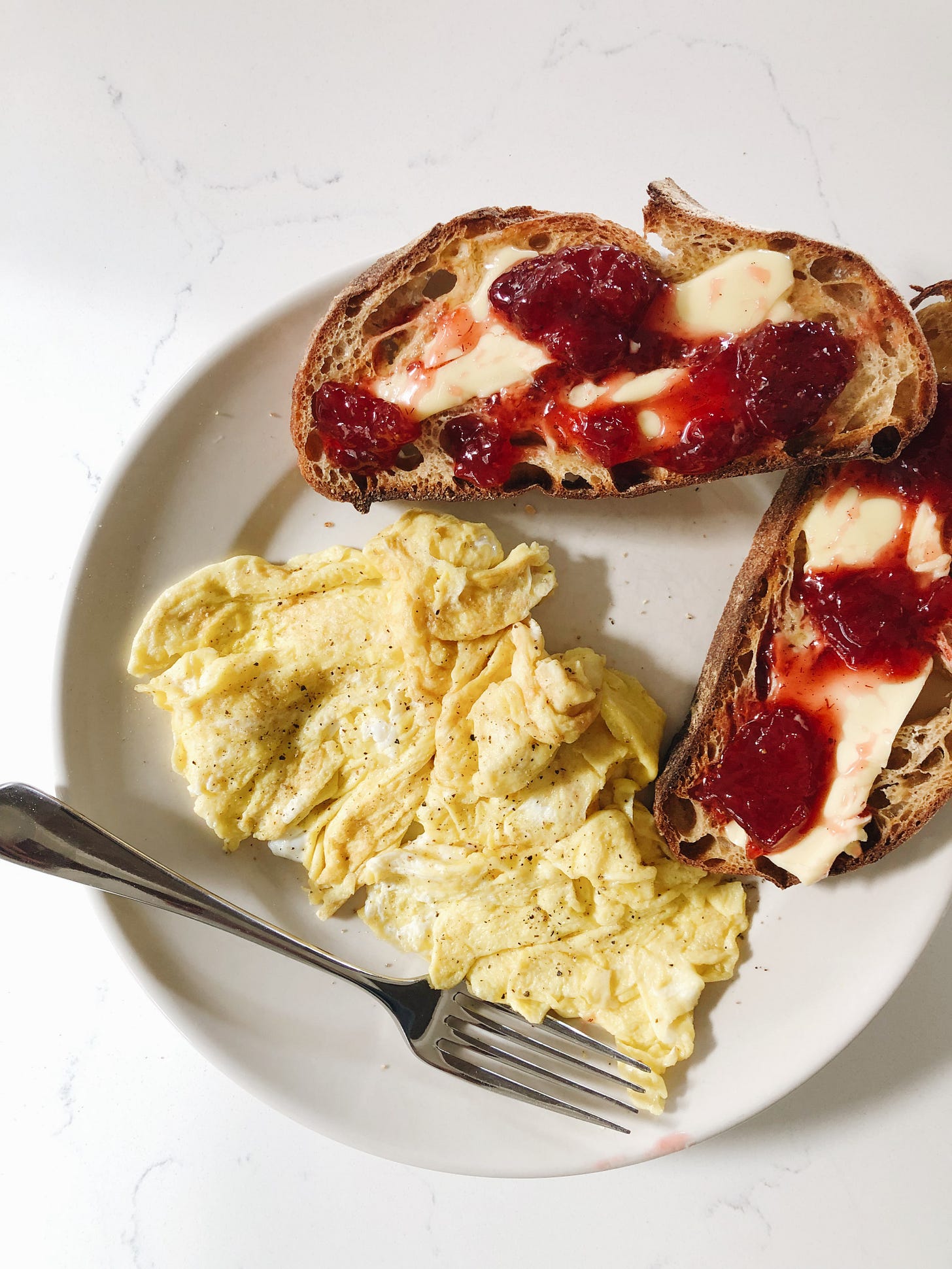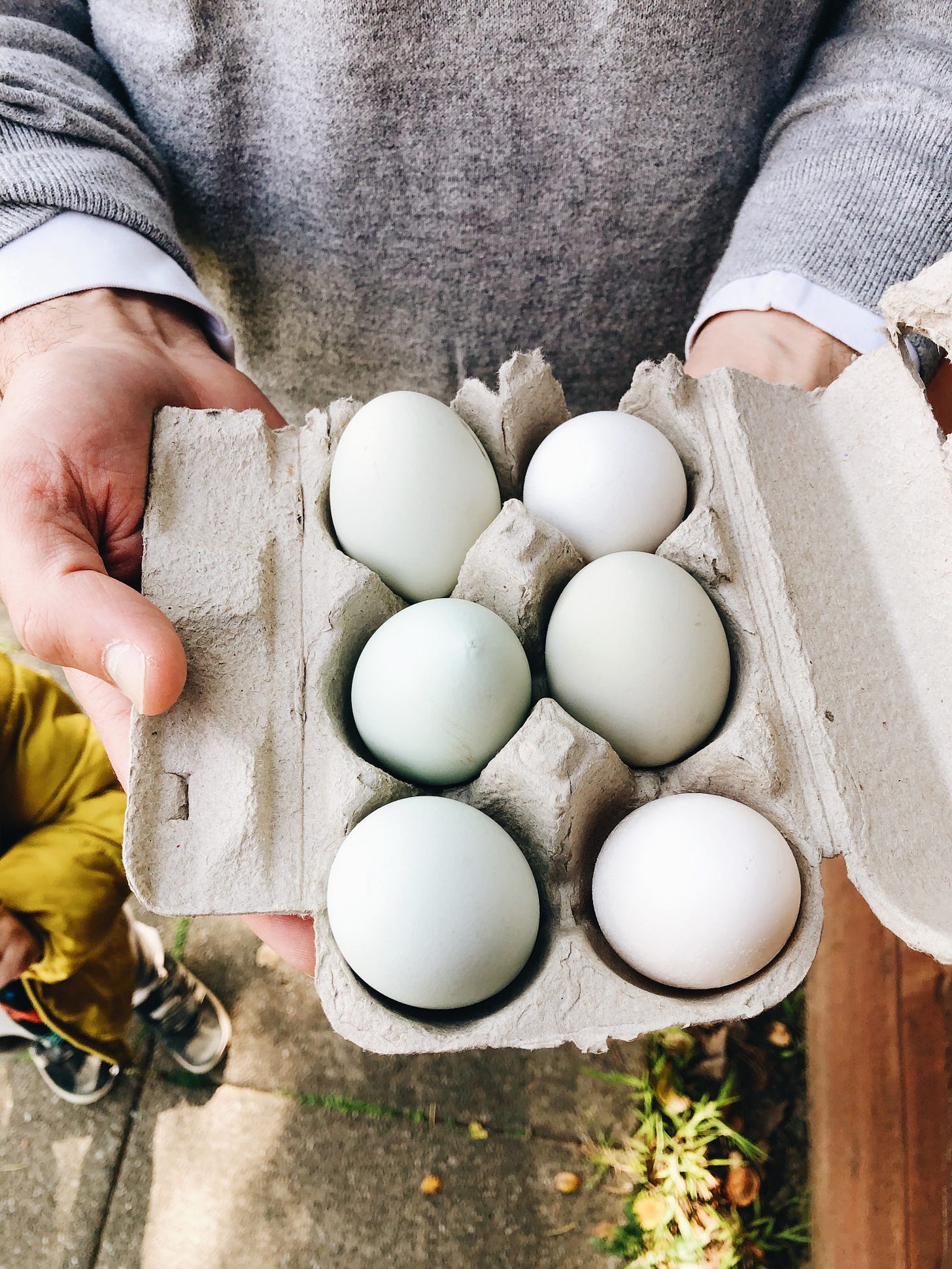Spring Things + Simple Strawberry Jam
First come the magnolias—seemingly out of nowhere. Bursting forth on bare branches. (“Most plants grow leaves before they have flowers,” I tell Arthur. “Mag-NO-lee-uh,” he replies.) Their pink-and-white petals, bigger than saucers, fall to the pavement and get crushed unappealingly underfoot. Then comes the wisteria. I can usually smell its lilac-clove-piney perfume before I see it. All over the Berkeley Hills, wisteria dangles from archways and fences, pergolas and façades. Wisteria winds its way up and across all manner of front yard architecture and manages to find a permanent position lodged in my brain. I think of it so often. I scan the houses whizzing by while I drive, with one eye forever on wisteria watch. It is magnificent—and then, it too falls, like confetti littering the sidewalk.
Spring has always felt like such a poignant time of year, as if I’m on the precipice of … something. I think this feeling has to do with all the contrasts: endings and beginnings; death and birth; the conclusion of cold weather and the harsh brightness of sun finally shining through. In my family, we lost Graham’s grandfather, his Jido, the weekend before Easter. He was 93 and he lived an inspiring, beautiful life as the pillar of the family, surrounded by kids and grandchildren. When I lived in Los Angeles, I wrote about Jido and his recipe for lamb tongue salad. His legacy lives on—I see so much of him in Graham and especially in our younger son, Lewis, who happened to turn two (!) yesterday. Graham and I also celebrated our birthdays recently, and Maddie’s is coming up next month.
I am going to try to make a giraffe-patterned cake for Lewie’s party this weekend. Wish me luck! Honestly not sure why cheetah print gets all the sartorial limelight when giraffe looks as good as it does.
The recipe I’d like to share with you today is Simple Strawberry Jam. Arthur and I made a batch together after I spotted small, bright red strawberries on sale at the market. (PSA for SF Bay Area friends: Berkeley Bowl currently has organic strawberry boxes, 2 for $5!) Arthur’s favorite step was smashing the fruit and sugar together, which is truly the ideal toddler sous chef job. Having a jar or two of homemade jam in the fridge means you can spread it on thick slabs of buttered toast. Or you can share some with a neighbor or friend. I think it would make a lovely Mother’s Day gift.
During this season of hope and renewal, I hope you find glimmers at every turn. We spent our spring break in the Santa Ynez Valley, which encouraged me to update our CA’s Central Coast Food Guide. If you need some super simple meals these days, please check out my recipes with Five or Fewer ingredients in the LA Times. I’ve been grateful to spend many hours in the garden, pulling endless weeds and prepping our vegetable boxes for their summer show. I took an apple tree grafting workshop at the University of California Botanical Garden and came home with two heirloom apple saplings that need to go into the ground soon.
I’ve been walking to preschool pick-up as often as I can swing it—all the better for wisteria ogling and, truthfully, for my mental health—and one of the great surprises has been seeing and saying hello to neighbors on the way. One day, Ellis’s family shared the prettiest light blue eggs laid by his backyard chickens. Another day, Raghav’s grandmothers shared homemade savory samosas and sweet kadubu. Little reminders of all the goodness in the world. I’m sending you much love and a big sticky strawberry jam kiss. xo
…
Simple Strawberry Jam
This simple strawberry jam is subtly flavored with lemon and vanilla, and the sweet-tartness of bright red strawberries shines through loud and clear. I know making jam can seem intimidating, but I promise it is an easy, straightforward process. Sometimes I like to make a mini batch of jam—just enough to fill a couple of jars—and then I don’t even bother with the preserving steps (sterilizing the jars, measuring the headspace at the top of the jar, boiling the filled jars in a water bath, etc.). You can do this, too (try a half-batch of this recipe), and store the jam in your refrigerator, where it will keep well for at least one week.
Makes about enough to fill six 8-ounce (240 ml) jars
4 pounds (1.8 kg) ripe stemmed strawberries
5 cups (1 kg) sugar
1 lemon
1 vanilla bean pod (optional)
Cut each strawberry into quarters if they are large or in half if they are small. Place in a large bowl and stir in the sugar. Use a potato masher or your hands to crush the fruit. Add a strip of the lemon peel and all the juice from the lemon. Slice open the vanilla bean lengthwise, scrape the tiny seeds into the bowl, and drop in the scraped pod as well. Cover and let stand for at least 30 minutes and up to overnight.
Put two or three small plates in the freezer.
Wash six 8-ounce (240 ml) glass jars and their lids with hot, soapy water. Choose a pot large enough to fit all the jars and tall enough that there can be at least 1 ½ inches (4 cm) of water above the top of each jar. Fill the pot with water and bring to a simmer. Most jam jars have lids that come apart into two pieces: a flat top and a metal ring. Place the flat tops in a bowl. Carefully lower the glass jars and metal rings into the simmering water to sterilize while you make the jam.
Transfer the strawberry mixture to a wide, heavy-bottomed pot and bring to a boil over high heat. Cook, stirring frequently and scraping the bottom and sides of the pot with a wooden spoon or heatproof rubber spatula, until the fruit breaks apart and the juices thicken, about 15 minutes. At first the fruit will release a lot of liquid and the jam will look like strawberry soup, but don’t worry—much of the water will evaporate while the jam cooks. Turn off the heat, then check the jam’s consistency by spooning a teaspoon or so onto one of the chilled plates. Return the plate (with the jam on it) to the freezer for 1 minute. Drag your fingertip through the jam—if it stays apart and doesn’t run back together, it’s done. If the juices spread across the area where you dragged your finger, cook the jam for another few minutes before checking the consistency again. You can also check for doneness by using an instant-read thermometer; as soon as the jam reaches 220°F (104°C), remove the pot from the heat.
Lift the empty jars out of the simmering water (keep the water at a simmer), allowing them to drain, and place upright next to the stove on a clean kitchen towel. Transfer the metal rings to the bowl with the flat tops, ladle hot water into the bowl, and let sterilize while you fill the jars.
Carefully ladle hot jam into each jar, leaving ¼ inch (6 mm) of headspace at the top of each jar. Using a damp towel, wipe the rims clean. Discard the lemon peel and vanilla pod. Put the flat tops on the jars, then screw on the metal rings, tightening them only to the point of resistance. Lower the filled jars into the pot of hot water. Simmer for 10 minutes.
Remove the jars from the water and place them on a clean kitchen towel in a spot where they won’t be bumped for 12 hours.
After 12 hours, check to make sure each jar sealed properly—the center of the lid should be concave, like a dimple. Any jars that didn’t seal should be stored in the refrigerator and eaten within 1 week. Label the sealed jars and store them in your pantry for up to 1 year.








